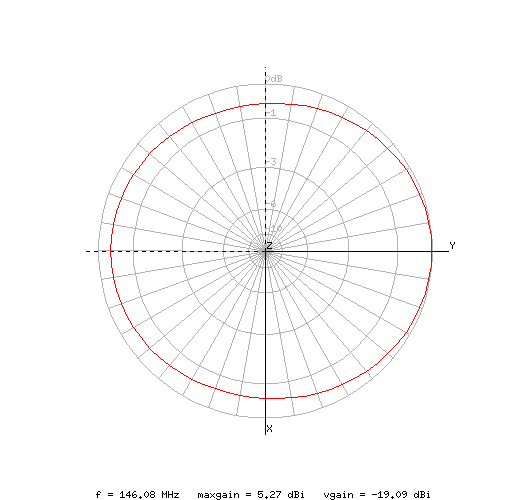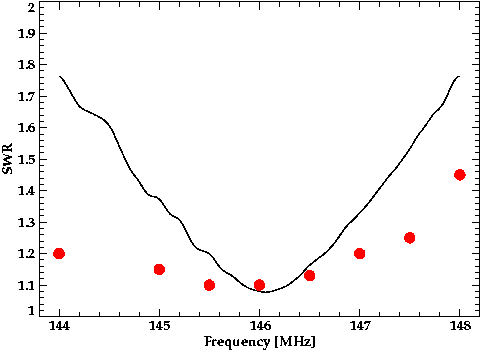High Gain Omni for MURS and 2-Meters
| Antenna Overview |
| VHF (2m/MURS) |
| Moxon Rectangle |
| Yagi-Uda |
| High-Gain Omni |
| UHF (70 cm) |
| Dual-Rectangle |
| HDTV |
| Hoverman |
| Gapless Hoverman |
| Extended Hoverman |
| jed |
| S-Lang |
| most |
| Complex Domain Coloring |
| SLxfig |
| Antennas |
| Thermochron |
| Main Page |
This page describes a simple to build, high gain, omni-directional direct-connect antenna for MURS and 2-meters. The antenna appears to be a type of center-fed collinear but does not require any sort of matching hardware when fed with 50 ohm coax. As the bandwidth of this antenna is rather small, the same antenna will not work on both bands simultaneously--- it must be built for one or the other.
The basic geometry of the antenna is given in the following figure:

As the figure shows, the antenna is asymmetrical about the vertical axis, which manifests itself in a slight azimuthal asymmetry in the radiation pattern, shown in the xnecview generated plot below.

The antenna achieves its gain through a ``flattening'' of the radiation pattern, as shown in the next figure:

The geometric parameters appropriate for the the 2-meter and MURS bands were determined to be:
2-meters MURS1-3
------------------------------------------------------
Wire #14 AWG #14 AWG
A1 4-11/16 in. 3-1/16 in.
A2 3-7/16 in. 3-15/16 in.
B1 7-1/4 in. 8-9/16 in.
B2 36-1/2 in. 35-1/8 in.
C 12 in. 10-15/16 in.
D 3 in. 3-1/16 in.
For both designs, the specification calls for bare #14 AWG
wire. I have no idea how a different wire size, or one with a
coated insulation will affect the design.
For the 2-meter version of the antenna, NEC-2 predicts the free-space gain to be 4.7 to 5.3 dBi with a 1.1:1 SWR and a feed-point impedance of close to 50 ohms at the center of the band. The .nec file for the 2-meter version may be found here. Similarly, NEC-2 predicts the gain to be between about 4.7 and 5.3 dBi for the MURS version of the antenna. And here is a link to its .nec file.
I constructed a prototype for the 2-meter band using the bare ground wire from ordinary 14 gauge NM electric cable. A simple structure composed of 3/4 inch PVC pipe was created to support the wire. Below is a picture of it being tested in my back yard along with a blow-up of the region of the feedpoint and choke balun. The choke-balun was constructed by wrapping 3-1/2 turns of the coax around a short 1-1/2 inch diameter piece of PVC pipe. Its purpose is to help reduce any feedline radiation that may be present.

The next figure shows a a plot of the NEC-2 predicted SWR curve (black) along with the actual values (red) measured during the test using my uncalibrated SWR meter.

I also measured the value of the SWR to be greater than 3 on MURS channel 1 (151.82 MHz). As expected, the bandwidth of the 2-meter version of this antenna is too small to be useful for MURS.
In summary, this is a simple high-gain omni-directional antenna to build and requires no tuning if built properly. As the antenna presents a balanced load and coaxial cable is intrinsically unbalanced, a 1-1 choke balun such as the one shown above is recommended. If the antenna performs according to the NEC-2 predictions, the antenna should run circles around a j-pole.